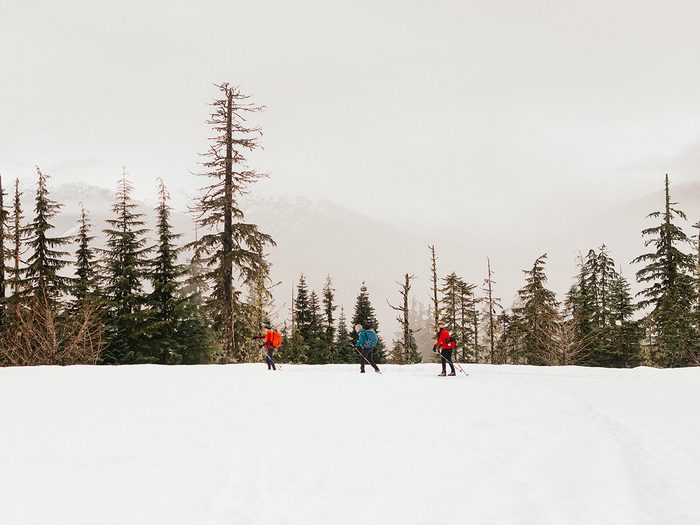How to Get Started with Cross-Country Skiing

Here's how to determine which Nordic skiing style is right for you, how to warm up and cool down, and where to go cross-country skiing in Canada.
Communities across the country have Nordic clubs where you can sign up for a lesson and rent equipment to try the sport. Additionally, many downhill resorts—such as SilverStar in B.C., Mont-Tremblant in Quebec and Ski Wentworth in Nova Scotia—have embraced a range of cold-weather pursuits, including snowshoeing, fat-tire snow biking and Nordic skiing. These spots often maintain cross-country trails, offer lessons and rent out Nordic gear.
“Lessons can be extremely helpful,” suggests Kelowna, B.C.-based Nordic coach Jenna Sim. “They provide a platform to give you the confidence for going out on your own.”
Plan a half-day lesson or a short ski for your first outing so you don’t overdo it, says Sim. The rental shop pros will be able to help you size your gear, and your instructor can show you how to put on and take off the boots and skis.
Know the terms
Classic vs. skate: What style of Nordic skiing is right for you?
At cross-country ski clubs, you’ll see trails with a set of tracks (two parallel grooves, hip-width apart) on each side, plus a wide area in the middle that looks like groomed corduroy. The tracks are for the classic style of Nordic skiing, while the part in the middle is for skate skiing. So, what’s the difference?
Classic skiing follows the basic human movement of walking or jogging, where each ski is in its own track and you stride or glide along, one ski at a time, while poling forward with the opposite arm. Many skiers new to the sport opt for this style as it’s more low-key and easy to learn.
Skate skiing involves shifting your weight from one leg to the other in a side-to-side motion, like you do when you’re ice skating (or on a flat cat-track, when alpine skiing). It requires more energy to get going, but skiers can achieve an almost effortless momentum, and it’s a great workout.
Each discipline requires its own specific skis, boots and poles, so it’s a good idea to decide on a style before you invest in gear. However, most Nordic clubs offer both kinds of skiing—classic skiers and skate skiers share the same trails—with a groomed trail in the middle, and tracks for classic on each side.
So then what’s telemark skiing?
Telemark is a niche style of downhill skiing that combines Nordic and alpine, and it’s not for beginners! The skis have edges like downhill skis, but use toe-only bindings like with Nordic skis. This results in turns that look like lunges, where the rear foot keeps balance while the front foot carves the turn.
How to Warm Up and Cool Down
Before you venture out, a little stretching will go a long way. All levels of skiers can benefit from a strength and mobility program, which can be added on to your existing home or gym exercise routine, says Ross McKinnon, a physiotherapist with Kelowna Manual Therapy Centre.
With Nordic skiing, your legs and hips extend through a larger range of motion than when you’re walking, explains McKinnon. Everyday exercises that are good for cross-country ski training include lunges, single squats, balancing on one leg and calf exercises such as heel drops on the stairs (with the knees straight and bent). Since hip and leg flexibility is important, McKinnon also recommends half-kneeling hip flexor stretches and sitting groin stretches before and after skiing.
Hold your stretches for 30 seconds and repeat three times. Exercises such as squats and lunges can be done until you start experiencing a slight fatigue in your muscles—usually after three sets of about 10 to 12 repetitions.
When you hit the trails, start with easier routes and plan to ski the same length of time as you would hike or walk.
“Take care during the first few sessions,” McKinnon adds. “As with any new activity, there can be some normal post-exercise soreness.” An après-ski hot tub soak can also work wonders.
(Related: How to Warm Up Properly Before a Winter Workout and What to Do After)
Here are a few places to give it a try, across Canada:
Where to Ski
British Columbia
Sovereign Lake
Adjacent to SilverStar Mountain Resort near Vernon, the 50 kilometres of Nordic trails here combine with the downhill resort’s 55-kilometre trail system to create the largest regularly groomed network of cross-country ski trails in Canada. sovereignlake.com
Ski Callaghan
Dog-friendly trails make the Callaghan Valley a great choice for families. Find this Nordic-focused resort just south of Whistler. callaghancountry.com
Alberta
Canmore Nordic Centre
More than 65 kilometres of trails combined with on-site rentals and lessons (available through Trail Sports) make this a good choice for trying out Nordic skiing. The centre is located in the Bow Valley, west of Calgary. albertaparks.ca
Manitoba
Windsor Park Nordic Centre
Groomed daily and perfect for beginners, the short easy loops at this Winnipeg facility are a great place to learn. Equipment rentals are on a first-come, first-served basis. windsorparknordic.ca
Ontario
Highlands Nordic
Located north of Toronto near Wasaga Beach, this Niagara escarpment spot rents out classic and skate skis to use on its 30 kilometres of groomed trails. highlandsnordic.ca
Quebec
Mont-Sainte-Anne
Less than an hour from Quebec City, the network of Nordic trails at this ski resort wind through the scenic Laurentian forest. The trails include five heated cabins where skiers can stop for a rest. mont-sainte-anne.com
Newfoundland
Clarenville Nordic Ski Club
The 40 kilometres of trails at this club, located east of the Bay du Nord Wilderness Reserve, have plenty of cozy warm-up huts along the way. clarenvillenordicskiclub.com




